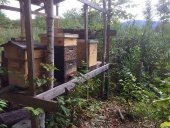




"If a man does not keep pace with his companions, perhaps it is because he hears a different drummer. Let him step to the music which he hears, however measured or far away." - Henry David Thoreau




find religion! church
kiva! hyvä! iloinen! pikkumaatila
get stung! beehives
be hospitable! host-a-hive
be antisocial! facespace













Krzysztof Plizga wrote:Get in contact with local beekeeper association or "bee club". They should know local sources for bees and equipment.
find religion! church
kiva! hyvä! iloinen! pikkumaatila
get stung! beehives
be hospitable! host-a-hive
be antisocial! facespace
 1
1




"If a man does not keep pace with his companions, perhaps it is because he hears a different drummer. Let him step to the music which he hears, however measured or far away." - Henry David Thoreau




Living in Anjou , France,
For the many not for the few
http://www.permies.com/t/80/31583/projects/Permie-Pennies-France#330873




 1
1





"If a man does not keep pace with his companions, perhaps it is because he hears a different drummer. Let him step to the music which he hears, however measured or far away." - Henry David Thoreau




Moderator, Treatment Free Beekeepers group on Facebook.
https://www.facebook.com/groups/treatmentfreebeekeepers/









"If a man does not keep pace with his companions, perhaps it is because he hears a different drummer. Let him step to the music which he hears, however measured or far away." - Henry David Thoreau




"If a man does not keep pace with his companions, perhaps it is because he hears a different drummer. Let him step to the music which he hears, however measured or far away." - Henry David Thoreau





find religion! church
kiva! hyvä! iloinen! pikkumaatila
get stung! beehives
be hospitable! host-a-hive
be antisocial! facespace




"If a man does not keep pace with his companions, perhaps it is because he hears a different drummer. Let him step to the music which he hears, however measured or far away." - Henry David Thoreau





Riley Walker wrote:I haven't had a chance to read your link yet, but I'll definitely add it to my bee reading list - I appreciate it!
When humans switched from hunting honeybee colonies living scattered in the wild to keeping them in hives crowded in apiaries, they may have greatly increased disease transmission between colonies. The effects of clustering colonies were studied. Two groups of 12 colonies, with hives crowded or dispersed, were established in a common environment and left untreated for mites. Drones made many homing errors in the crowded group, but not in the dispersed group. In early summer, in both groups, the colonies that did not swarm developed high mite counts, but the colonies that swarmed maintained low mite counts. In late summer, in the crowded group but not in the dispersed group, the colonies that swarmed also developed high mite counts. All colonies with high mite counts in late summer died over winter; all colonies with low mite counts in late summer survived over winter. Evidently, swarming can reduce a colony’s mite load, but when colonies are crowded in apiaries, this mite-load reduction is erased as mites are spread through drifting and robbing.
find religion! church
kiva! hyvä! iloinen! pikkumaatila
get stung! beehives
be hospitable! host-a-hive
be antisocial! facespace

|
This tiny ad dresses like this just to get attention:
Rocket Mass Heater Resources Wiki
https://permies.com/w/rmh-resources
|






